
December 2, 2022 THE YEAR SCROOGE, TINY TIM AND THE GHOSTS OF CHRISTMASES PAST, PRESENT & FUTURE CAME TO BOSTON
In 1867, Charles Dickens arrived in Boston for the first public reading of A Christmas Carol in the United States, an event that took place at Tremont Temple. His visit was arranged by his friend and official American publisher, James Fields of the firm of Ticknor & Fields, which put Boston’s Old Corner Bookstore on the American literary map. Dickens stayed at the Parker House, the predecessor of today’s Omni Parker House Hotel at the corner of Tremont and School Streets. To get you in the holiday spirit, we’re re-sharing a post from December 2017 by historian Susan Wilson, who describes the famed author’s stay and the Christmas Carol’s legacy in Boston. Happy Holidays!
Over the past century and a half, British novelist Charles Dickens’ works, his name, his spirit, his room décor — and maybe even his ghost — have all become part of the fabric at the Omni Parker House.
Charles Dickens made the Parker House his home base for five months during his 1867-68 stateside visit — the second of only two trips he ever made to America. After arriving in Boston Harbor on the steamship Cuba the evening of November 19, 1867, the literary superstar was whisked away to the Parker House, where he was greeted by the hotel’s owner and founder, Harvey Parker, and his business partner John F. Mills.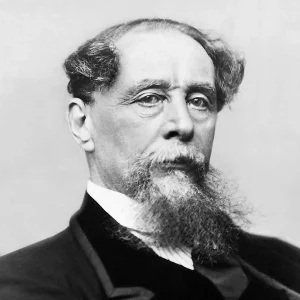
On November 30, Dickens joined members of the prestigious Saturday Club — whose literary members included Henry Wadsworth Longfellow, Ralph Waldo Emerson, and Oliver Wendell Holmes, Jr. — for one particularly memorable meeting. Among Dickens’ noted contributions was a favorite punch concocted on site after his assistant George Dolby pulled a stash of fine gin off the Cunard liner docked nearby. According to popular legend, Dickens offered a sneak preview of his popular novella, “A Christmas Carol,” to this group that day as well.
Two days later, Dickens gave his first public American reading of “A Christmas Carol” at Tremont Temple, just behind the hotel. Attended by what The New York Times called “one of the most appreciative, fashionable and brilliant audiences ever assembled in New-England,” the reading was a complete one-man show that kept the overflow audience spellbound and reduced them to tears. A follow-up performance on Christmas Eve had the same effect.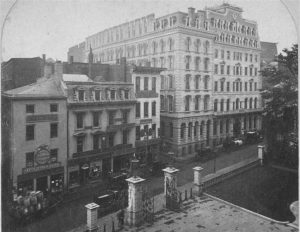
When he spoke, Dickens used his classic stage props: gas lamps lighting a large maroon backdrop, a waist-high podium desk with a block for resting his elbow, and a rail below for his foot. Dickens began his two-hour performances precisely at eight o’clock, opening with a 90-minute reading, followed by a short intermission, then ending with a second, short reading.
Dickens’ presence in Boston always created a stir. When staying at the Parker House, he took eight-mile walks almost every afternoon, dressed flamboyantly in a brightly colored coat and shiny boots, accessorized with striped cravat, fine hat, and gloves. Guards were regularly assigned to his hotel room door, since curious fans were eager to catch a glimpse of their favorite writer rehearsing the exaggerated gestures and odd facial expressions he used to create characters in his public readings. The colorful Dickens preened and practiced his animated talks in front of a large mirror now displayed in the mezzanine-level hallway by the Press Room.
“A Christmas Carol” was originally published in Britain in 1843. Over the following two decades, more than a dozen American versions were printed (the lack of copyright protection gave these publishers a field day). Dickens found a friend in publisher James T. Fields of Old Corner Bookstore fame, whose office was located a stone’s throw from the Parker House — and who worked out a generous system of royalties for Dickens and other authors. His company, Ticknor & Fields, published a special ”Diamond Edition,” issued to coincide with Dickens’ 1867 American reading tour.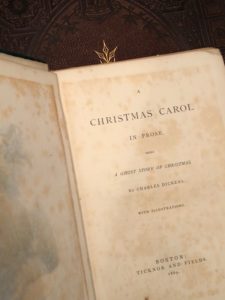
In 1926, half a century after Dickens’ departure, a member of the Swift-McNutt wrecking company was working on the demolition of the old Parker House, making way for today’s more modern structure. Seeing that one particular door was labeled as the entrance to the Dickens suite, the worker hauled it off to the nearest historical society he could find: The Bostonian Society in the Old State House. Not able to display the artifact, the Bostonian Society carefully placed it in storage, where it remained for almost ninety years. In 2015, they graciously gifted the door back to the Parker House, where it proudly stands in the lower lobby level History Gallery.
DICKENS AND CHRISTMAS
It’s hard to imagine a winter holiday season without a reading of “A Christmas Carol.” But that’s how it was in Puritan Boston, which alternately banned or frowned on raucous Christmas celebrations for more than two centuries. By 1867, however, when Dickens made Boston and the Parker House home, Christmas was slowly making a comeback. The author and his novella contributed greatly to the modern version of Christmas that Boston came to embrace — one that stressed the importance of charity and good will towards all humankind. Finally, in 1870, President Ulysses S. Grant made Christmas a national holiday.
FOREVER DICKENS?
Well, maybe. Charles Dickens stayed on the third floor of the Parker House in 1867-68, and some say his ghost returned there when the author died in 1870. Rumor has it that one of the hotel elevators will occasionally travel to the third floor without the buttons being pushed.
DICKENS DISPLAYS you can visit at the Omni Parker House
Lobby Display: “Dickens Days at the Parker House:”
Includes stories, images, a slide show, and artifacts related to Dickens’ 5-month stay at the Parker House, 1867-68.
The Dickens Mirror:
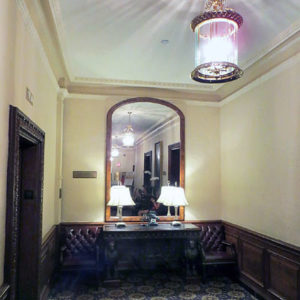 In the mezzanine hallway next to the Press Room stands the huge mirror Charles Dickens used to practice his animated and very theatrical readings. A perfect spot for selfies.
In the mezzanine hallway next to the Press Room stands the huge mirror Charles Dickens used to practice his animated and very theatrical readings. A perfect spot for selfies.
The Dickens Door:
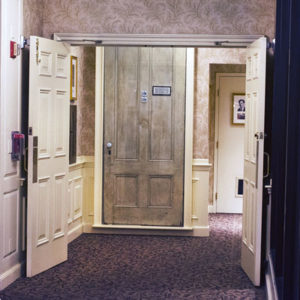 The eight-foot tall “Dickens Door” displayed in the lower lobby level History Gallery stood at the entrance to the third-floor suite occupied by Dickens during his final visit to the United States.
The eight-foot tall “Dickens Door” displayed in the lower lobby level History Gallery stood at the entrance to the third-floor suite occupied by Dickens during his final visit to the United States.
© 2017 by Susan Wilson, House Historian of the Omni Parker House



